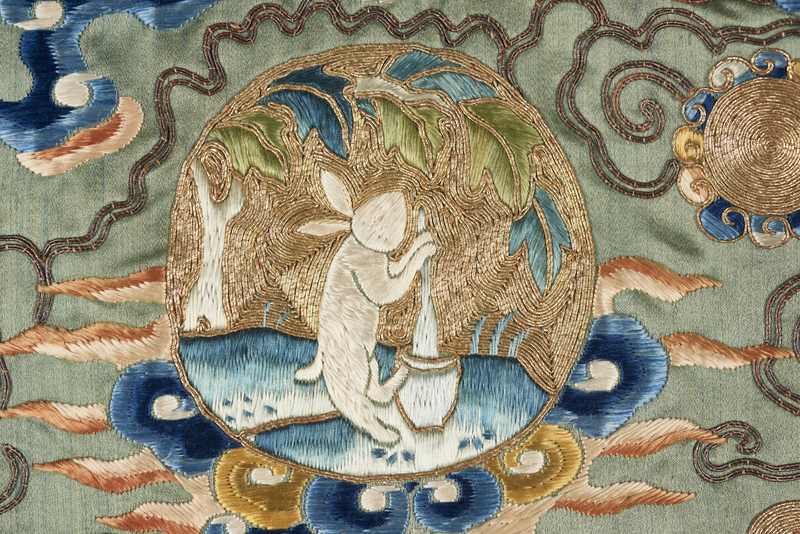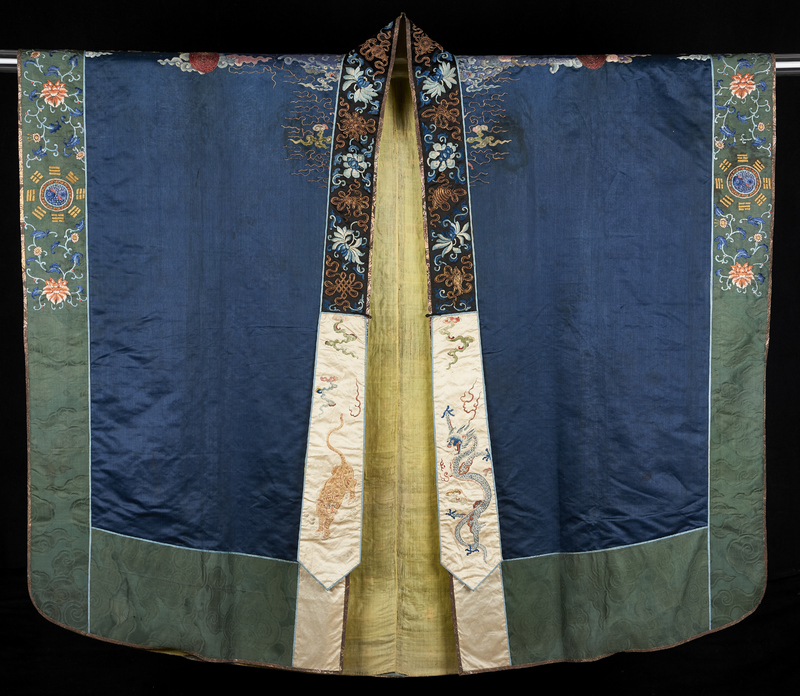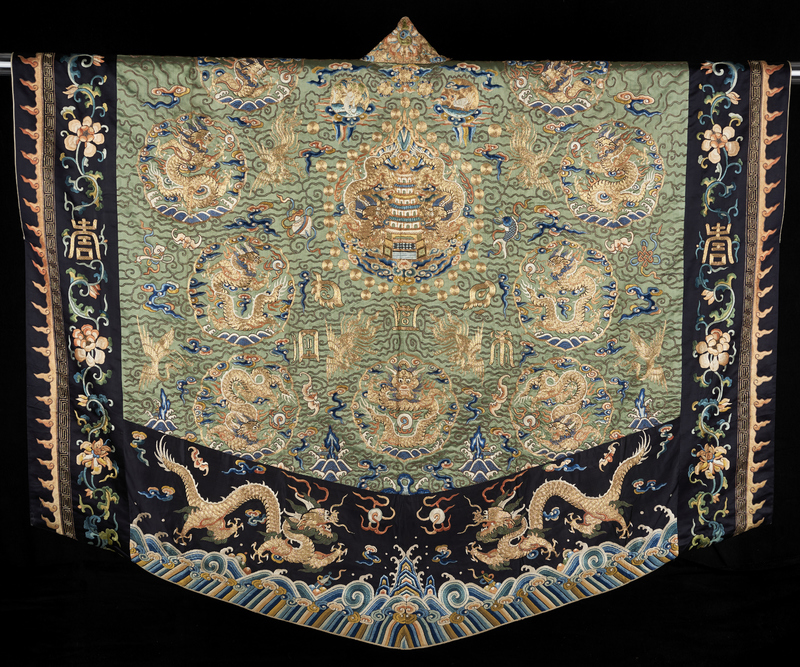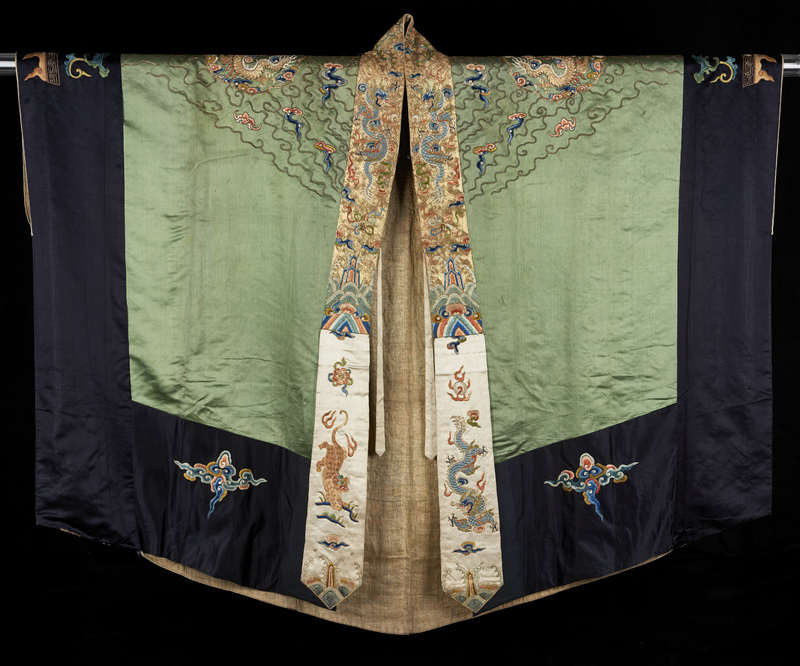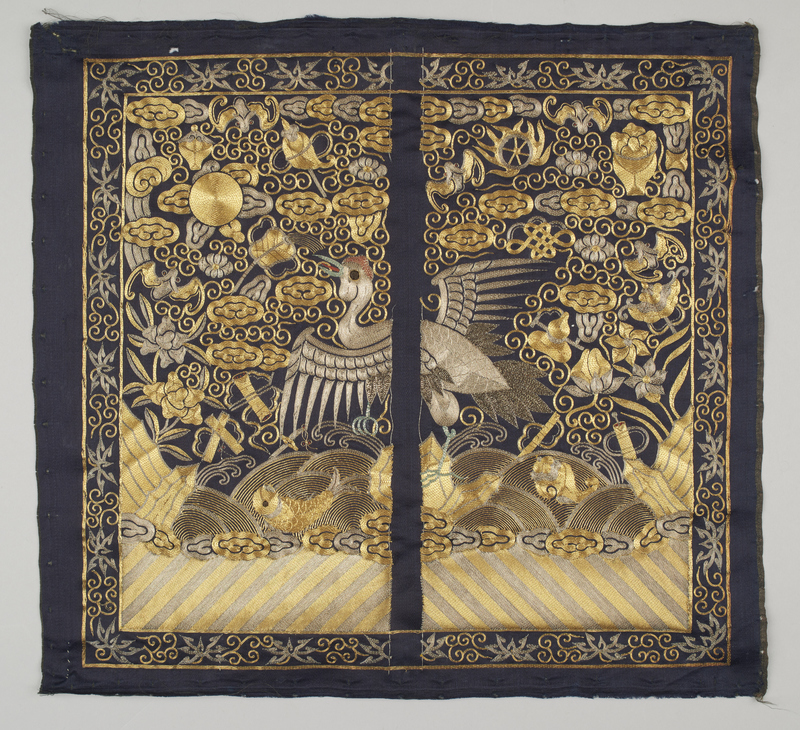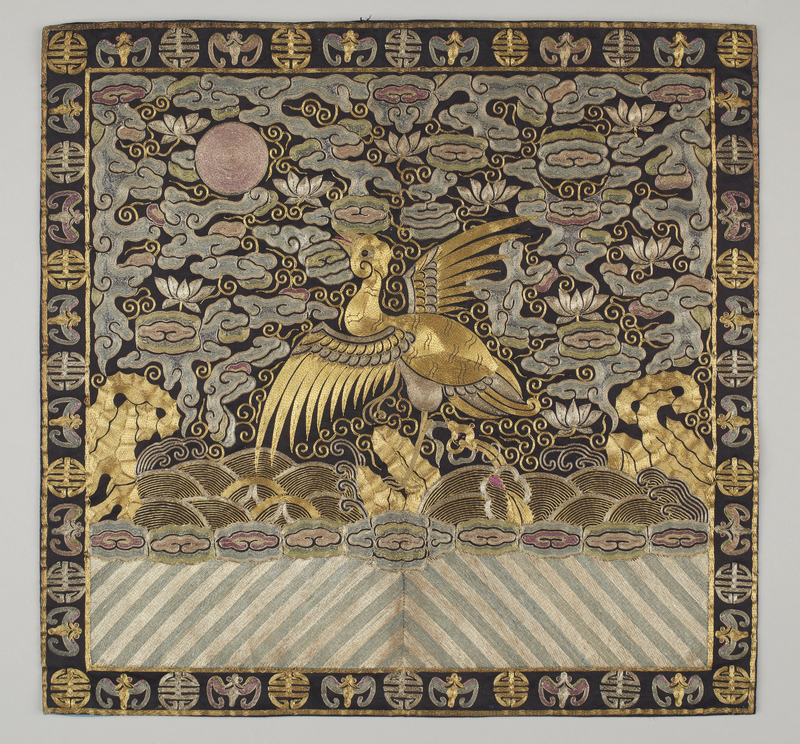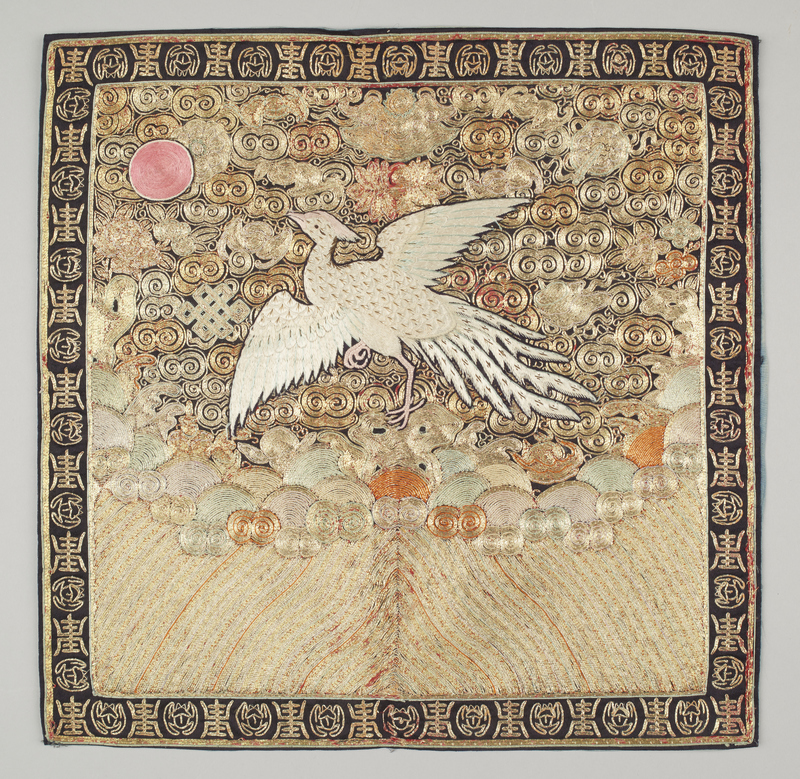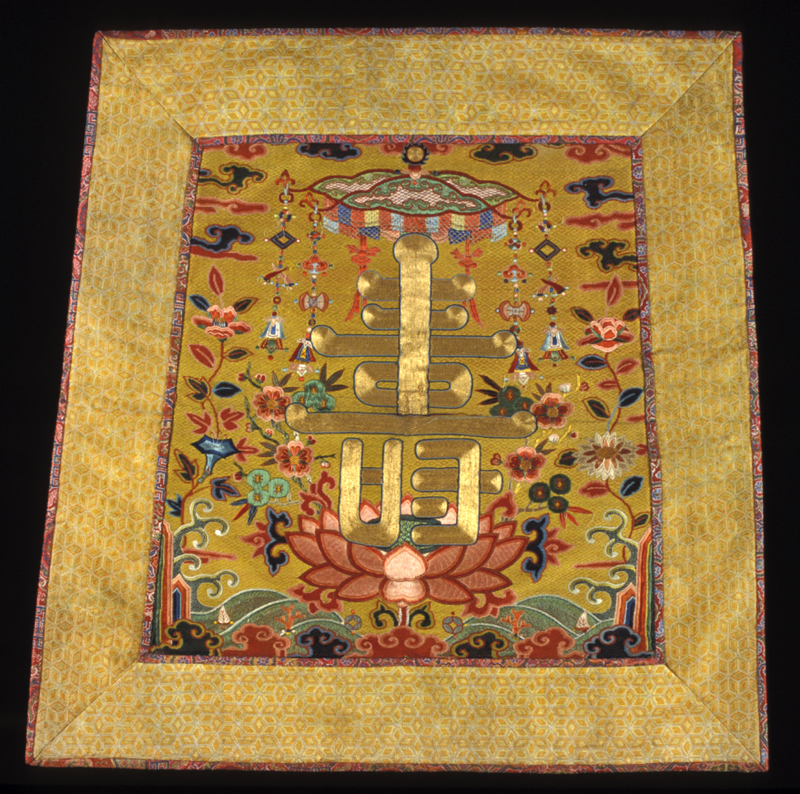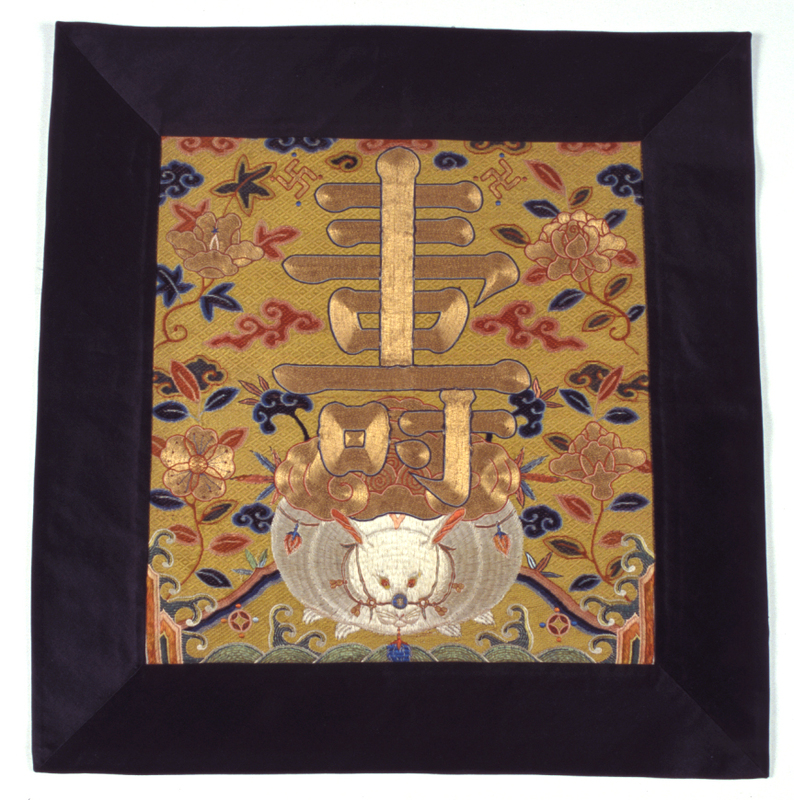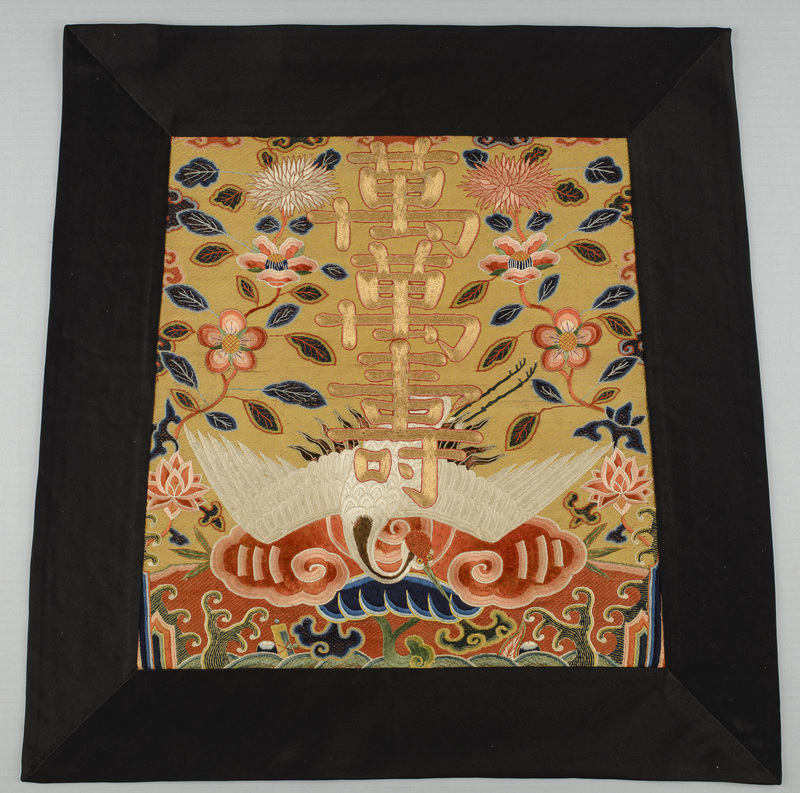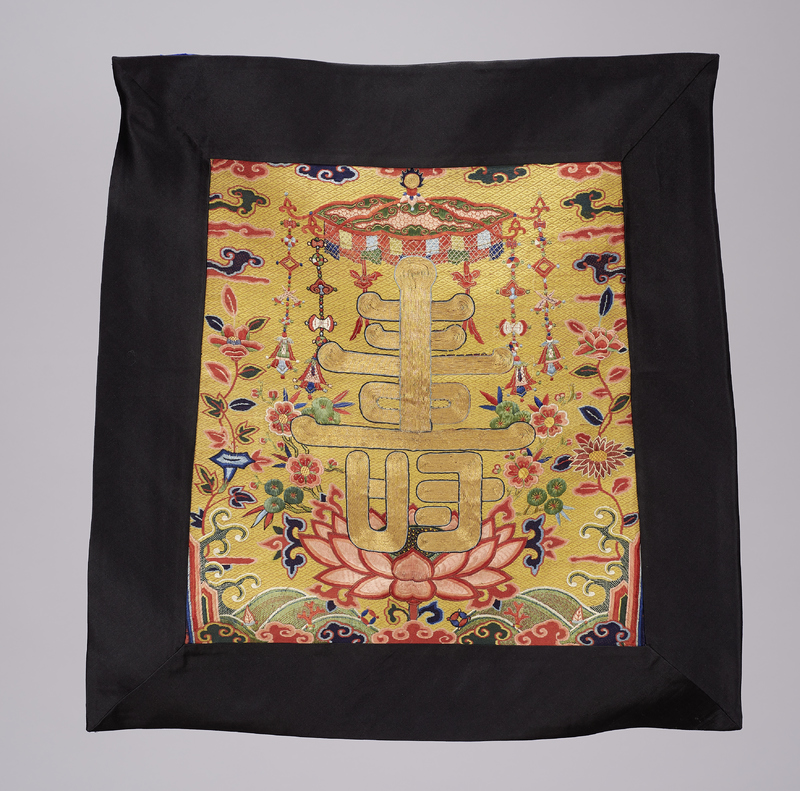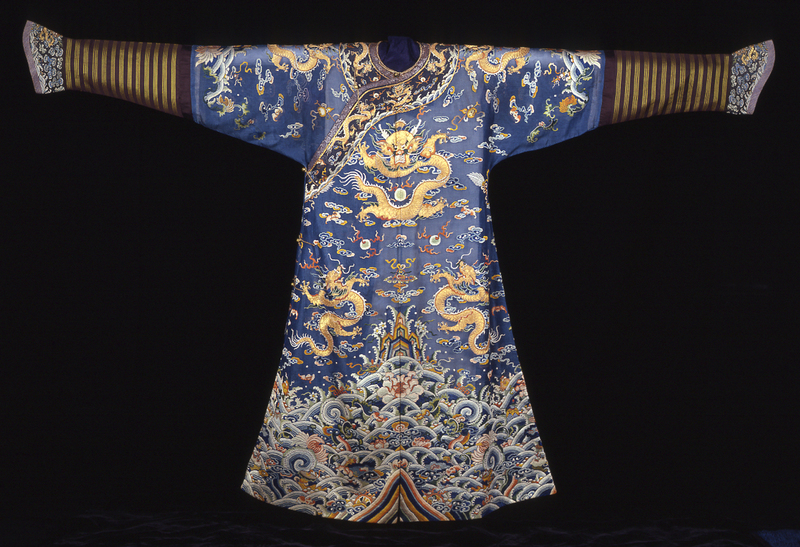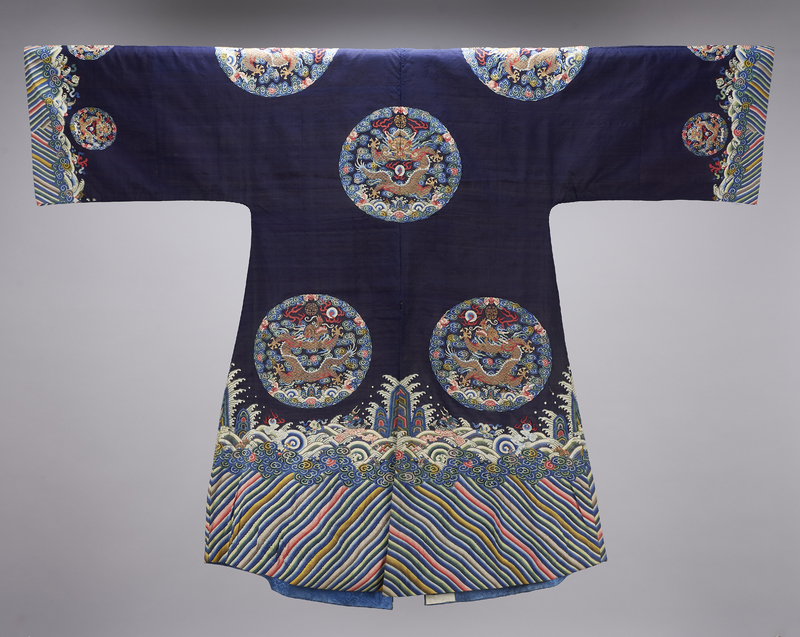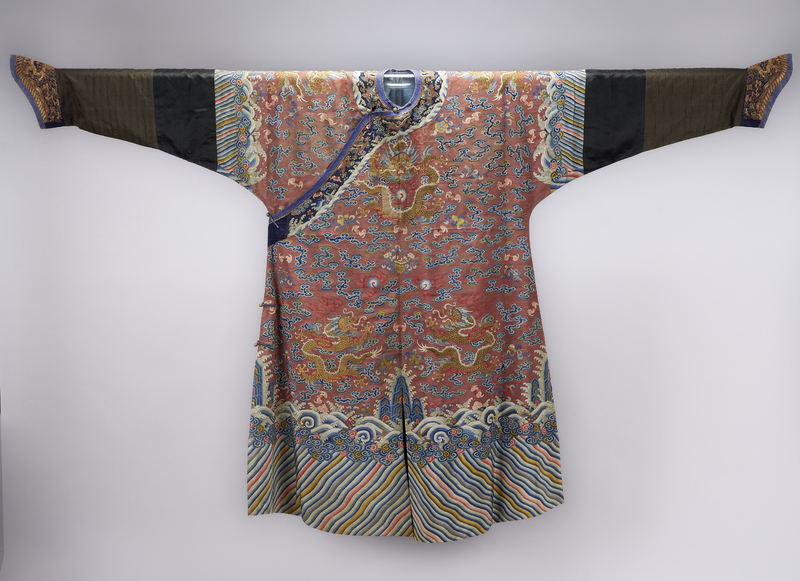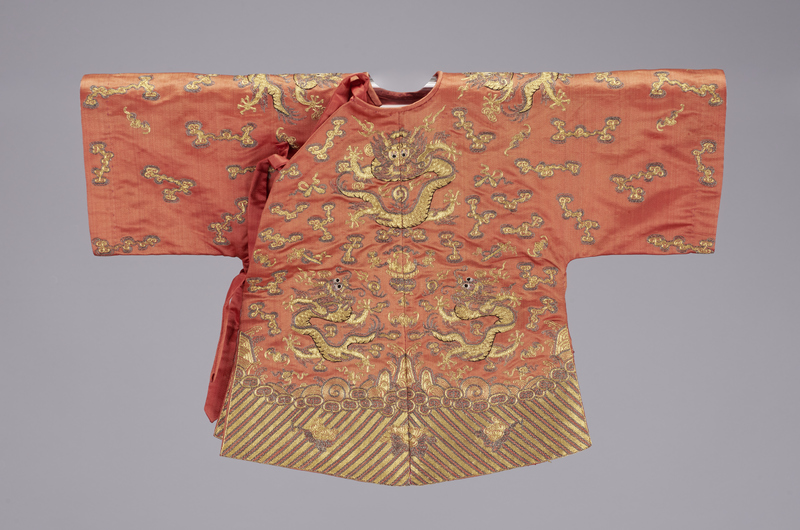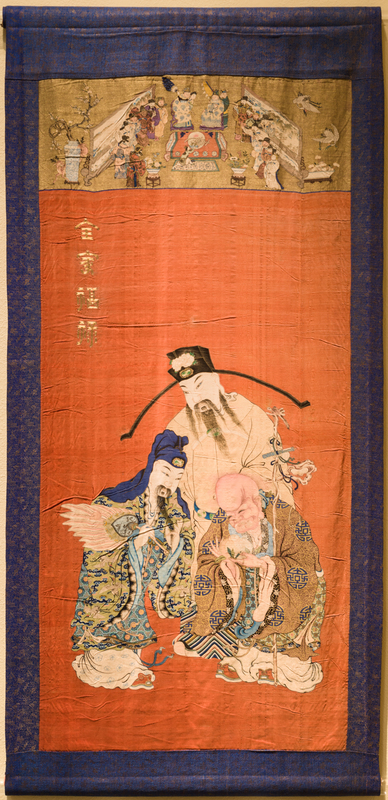Collecting Silk
Gertrude Bass Warner collected art extensively throughout Asia, especially in China. She was particularly drawn to silk textiles and the people who produced them, primarily the women in private households and commercial workshops. It was only in the 17th century when the production of court orders began to overwhelm the imperial workshops that commercial workshops took over some of the production. In these commercial workshops, most of them located in the Jiangnan area, the center of China’s silk production, male weavers relegated women to the groundworks of silk production: the rearing of the silkworms and reeling the silk off the cocoons. Embroidery remained the domain of women. They were the master embroiderers who developed the art to its height in the Qing Dynasty (1644-1911). Their legacy can be admired in the textiles from the Warner collection.
Different from the post-Renaissance distinction between “fine arts” (painting, drawing, sculpture and photography) and “decorative arts (and crafts)” invented by western art historians, in China silk textiles have been regarded since time immemorial as refined pieces of art that carried multiple levels of meaning beyond the beauty of style.
Although people of high social class who wore high-quality status garments knew little about the details of the labor-intensive silk-production process , they craved fabrics with the most intricate patterns and exclusive decoration and were quality- and fashion-oriented to a degree that inspired strict sumptuary laws since the earliest dynasties.
These laws regulated cut and color of the garments worn by the imperial family, the nobility, and officials for various celebratory occasions, for periods of mourning and in everyday life. Elegant silk fabrics dressed the elite, reflected spiritual beliefs and mirrored cultural ideals. It is therefore not surprising that the silk trade thrived and that coveted bolts of silk were used as imperial awards and emoluments, as well as a currency for negotiating peace with China's steppe neighbors.
Gertrude Bass Warner took an interest in collecting textiles for her museum because she recognized the enormous labor and the technical sophistication that Chinese status garments represent beyond their sheer material worth. In addition, she deeply valued the work done by women, from raising the silkworms to creating the fine embroidery that adorns both sophisticated robes and humble sleeve bands.
Warner's collection reflects her acknowledgement of the female contribution to China’s economy of silk production. It consists of almost 700 pieces and includes all categories of official and non-official Qing robes (which in accordance with the Huangchao liqi tushi 皇朝禮器圖式 [Illustrated Ritual Objects for Our Dynasty][1] commissioned by the Qianlong emperor [1711-1799; r. 1735-1796] are further categorized into formal, semi-formal, and informal robes) as well as skirts, sleeve bands, sophisticated horizontal and vertical ceremonial hangings, as well as furniture covers and pillows.
Silk robes were part of the identity of the imperial clan and its government. When the Qing dynasty ended, the textiles—once part of the visual language of power—lost their significance and transformed into collectibles for the art and antiques market. Now associated with the demise of Qing power, their owners sold them. Only very briefly, from January through March 1916, General Yuan Shikai (1859-1916) thought of creating a new dynasty. Yuan’s efforts to make himself the emperor were in vain: he died three months later, in March 1916. During this brief period of power, Yuan devised the creation of new court robes and military outfits, following the code of the Sanli tu 三禮圖 (Illustrated edition of the Three Ritual Classics) from the Song dynasty[2]. One of these sets was acquired by Gertrude Bass Warner. Warner’s care for the collection did not end with their acquisitions: during several of her later travels to China in the 1930s she took robes back to Beijing to be mended by specialist silk conservators.
Ceremonial and decorative hangings
Daoist robes
Daoist Robes
Cloak-like vestments worn by Daoist priests are called jiangyi (降衣) or "robes of descent."[3] The name refers to notion that the wearer invokes Daoist deities to descend in order to be present during specific rituals.
Daoist ceremonies can be performed in temples, but are also conducted at outdoor altars erected in open spaces, for instance when a priest is called to perform rituals before a funeral, in which case the robe functions as a temple, with the most complex representation of the Daoist cosmos on the celebrant’s back signifying the “north wall,” and its two front panels with protective directional animals—(the white tiger of the West and blue-green dragon of the East) guarding its “entrance.”
By donning the robe, the priest creates a sacred space in addition to the sacred area signified by the temporary altar, with his own body as the central conduit connecting him with the deities he visualizes and invites to descend into his body. He recites prayers and performs ritual movements in a proscribed sequence, whose meaning is known only to initiates. The congregation faces the priest’s back for most of the ritual. At defined times during the ritual the priest may descend to the level of the lay congregation, an alternative explanation for the term robe of descend.[4]
The iconography of Daoist jiangyi is complex and the symbolism is consistent, though the composition and execution, usually in colorful embroidery, can show great variety, enhancing the robes’ visual splendor.
The canon of symbols seen on Daoist robes consists of the cosmic diagram usually placed in the center on the back of the robe. It represents the cosmic order in the paradisiac realm of the immortals and features a central pagoda-like tower, in which the immortals are thought to dwell. The tower is set inside a teardrop-shaped border, often surrounded by flames. Star constellations, clouds, and rainbows fill the cosmic diagram, beneath depictions of the sun and moon, which are often shown as discs couched with gold- and silver-wrapped thread and are sometimes enhanced by representations of the three-legged bird of the sun and the jade rabbit pounding the elixir of immortality in the moon.
The central tower of the immortals is usually surrounded by discs symbolizing the twenty-eight Lunar Mansions, beneath or next to which are talismanic emblems representing the five Daoist sacred mountains that guard the five directions.
In addition to the cosmic diagram, a plethora of Daoist and Buddhist auspicious symbols are found on Daoist robes, reflecting the syncretism of Chinese religious practices and visual representations. The symbols include the Neo-Daoist “ten longevities” (Manchurian crane, tortoise, spotted deer, sacred lingzhi fungus, pine, bamboo, sun, clouds, mountains, and waves), the eight precious symbols of Buddhism (conch, wheel of teaching, canopy, vase, umbrella, endless knot, lotus, and double fish). In addition, they incorporate imagery of animals that symbolize protection and harmonious balance of the directions (tortoise, phoenix, tiger, and dragon as well as qilin (a mythical animal said to appear only during the reign of a truly virtuous ruler), the circular Yinyang-symbol (which represents balance between the negative and positive forces), the eight trigrams from the divination manual Yijing (the Classic of Changes, which analyzes combinations of the three sectors of the intelligible universe—heaven, earth, man) the eight Daoist immortals (Han Xiangzi, Cao Gaojiu, Lan Caihe, Li Tieguai, Zhang Guolao, Zhongli Quan, Lü Dongbin, and He Xian’gu) and/or their attributes, the five colors (green, red, yellow, white, black), and the eight treasures of wealth and prosperity (pearls, coral, coins, rhinoceros horn, silk, silver ingot, lozenge, and ruyi, or “as you wish,” scepter—a talismanic object intended to empower its owner to conjure desirable life conditions).
Daoist robes are of a remarkably simple shape with two full widths of uncut silk laid over each shoulder and seamed vertically down the center of the wearer’s back, reflecting “the precepts of Daoism that stress the value of unworked materials.”[5] They usually resemble a square sleeveless cape or poncho that opens at the front. A robe of just such design was found in a recent excavation of a tomb from the Jin dynasty (1115-1234). The sides and hems of Daoist robes have broad decorated borders; the collar is vertically extended in pieces of contrasting color, showing tiger and dragon, the guardians of the directions west and east. The sides are sewn together, leaving only the top open for the priest’s hands. There are selected Qing-dynasty (1644-1912) robes with wide sleeves instead of the openings in the sides for the priest’s hands. Most of these were made in the professional silk weaving and embroidering workshops of Suzhou, Hangzhou, and Nanjing.
Rank badges
Identifying the rank of an imperial official by a signifier on his dress was since the Yuan dynasty (1279-1368) made possible through a system of badges decorated with birds and (mythical) animals revealing the wearer’s personal status. The Ming dynasty (1368-1644) elaborated the system further assigning badges of birds to the nine ranks of civil officials and badges of animals to the nine ranks of military officials beginning in 1527. The badges had a trapezoidal shape and no border.
In the Qing dynasty (1644-1911) this system was continued. Surcoats of the Qing were buttoned in the front, thus the rank badge on the front of the coat was split. Court rank badges include the sun as the point of orientation towards which the birds and beasts turn their head. Principal wives and male children of an official were allowed to wear his rank badge as well.
Ming/Qing civil officials’ rank badge décor with birds[6]
1st: crane
2nd: golden pheasant
3rd: peacock
4th: wild goose
5th: silver pheasant
6th: egret
7th: mandarin duck
8th: oriole/quail
9th: quail/paradise flycatcher
Ming/Qing military officials’ rank badge décor with animals[7]
1st: lion/lion; after 1662 qilin
2nd: lion/lion
3rd: tiger and/or leopard/tiger; after 1664 leopard
4th: tiger and/or leopard/leopard; after 1664 tiger
5th: bear/bear
6th: panther/panther
7th: panther/panther; after 1766 rhinoceros
8th: rhinoceros/rhinoceros
9th: sea horse/sea horse
Festival badges
In the Ming dynasty, officials, their wives, and court eunuchs were required to wear festival badges on the front and back of plain robes matching the respective seasonal festivals celebrating the sun, the moon, the stars and the ancestors respectively.[8] Font and back versions of these festival badges were not identical like the regular court rank badges for officials, instead the imagery on front and back was complementary. The festival badges contain a plethora of auspicious symbols and visual puns. With the fall of the Ming the court festival badges were no longer used. Today few of these badges survive, luckily the Warner collection has four of them. One festival badge shows the character shou 壽 for long life embroidered in gold in the shape of a lantern with a canopy and decorative flyers on a lotus flower base. The Warner collection has two versions of it, one with a golden border, a second one with a black border. These badges were worn during the Lantern Festival at the end of the spring festival at the beginning of the New Year according to the lunar calendar. The second court festival badge shows the white rabbit that symbolizes the moon and carries the character shou 壽 for long life embroidered in gold on its back. It is further adorned with auspicious symbols such as the Buddhist swastika sign and clouds in the shape of a ruyi 如意= “as you wish” scepter and has an elegant black border. It was worn during the Mid-Autumn Festival in celebration of the harvest moon. The third festival badge has a black border and depicts a crane carrying the wish for a myriad of years in a long life (wanwan shou 萬萬壽) on its back. The crane itself symbolizes immortality. It was probably worn in celebration of the birthday of a member of the imperial family.
Dragon robes
The dragon is the imperial emblem of power. A mythical beast, the dragon is associated with innate forces of nature, such as wind and thunder, but also the animating force of a mountain, whose ridges are often associated with a dragon’s spine. The dragon can preserve life by bringing rain or destroy it with hail and lightning, and thus it is seen as an expression of the cosmic forces influencing earthly events. Therefore, the emperor who wears a dragon robe connects to these forces, just the Daoist priest who wears a “robe of descent” (i.e., formal Daoist robe) connects to the deities he invokes through rituals.
The dragon symbolizes the emperor and the eastern direction, which is associated with the color blue/green and the male principle yang (陽). Since the Yuan Dynasty (1279-1368) the dragon robe worn by the emperor at court had a five-clawed dragon chasing the pearl of wisdom, while the dragons adorning robes worn by imperial princes had four claws. In the third century of the Ming Dynasty (1368-1644) the iconography of imperial robes included a mountain standing for the axis mundi and waves symbolizing the ocean at the bottom. The Manchu Qing Dynasty (1644-1911) changed the iconography of the imperial attire to consist of a total of nine dragons, four visible on the upper robe, one on the inside of the overlapping part of the robe, and four on the skirt.
The twelve emblems of imperial power date back to legendary emperor Shun who is quoted in the Shujing (Classic of Documents) as listing them as the décor elements on official robes. They were included in the official iconography for dragon robes in the Qing Dynasty (after 1759), an act of legitimization linking Manchu rule to the authority of the Classical Chinese symbolism for imperial power.
Collectively they constitute an astronomical diagram referring to the celestial and terrestrial forces to which the emperor performed sacrifices in annual rituals at their respective altars situated in the four cardinal directions. The Altar of the Sun was located in the East, the Altar of the Moon was located in the West, the Altar of Heaven was located in the South, and the Altar of the Earth was located in the North.
The iconography of the Twelve Symbols places the emperor who is wearing the robe at the ritual center of cosmic space. He is then the pivotal point of the phenomena that resonate in space and time of the cosmic web: the twelve hours of the day, twelve months of the year and twelve zodiac signs, the twelve directions and the twelve musical notes.
On the shoulders of the robe are seen the Sun (with the three-legged bird) and the Moon (with the hare pounding the elixir of immortality and a cassia tree).
On the upper front part of the robe is the Star Constellation of three stars of the Big Dipper’s axle (symbolizing the center of Heaven in the Big Dipper); a pair of bows in mirror image called fu 黼 (the visual association with the winter solstice and the return of the longer days of spring) and an ax (fu 黼), symbolizing the emperor’s power over life and death associated with executions performed on the day of the autumn equinox.
The upper back part of the robe shows a pair of dragons symbolizing the changes of light and darkness marked by the summer solstice, and a pheasant, which is associated with the Red Bird star constellation of the South that appears in the sky around the spring equinox.
The lower section of the dragon robe shows symbols associated with four of the Daoist Five Phases (of change) or Five Elements (water, metal, fire, wood, and earth), which are placed above the border of water.
On the front a pair of sacrificial cups that align with the axe symbolize the spring equinox; aquatic grass aligned with the fu symbol stands for the winter solstice. The millet grains on the back symbolize the element wood (spring) and align with the pheasant associated with the spring equinox; and the flames align with the dragons and represent the summer solstice. The fifth element, earth, which represents the center, is symbolized by the mountain, that is placed in the center on the front and back (and at the slit on either side) of the robe.
Image robe
Dragon robe for a religious statue, also called “image robe”
This Qing-dynasty robe, probably produced between 1860 and 1890, was created to clothe a Daoist or Buddhist statue. It is made of salmon-colored satin and is unlined uncommon for such robes, which were usually lined with linen or hemp. It features ten roundels (different from ceremonial imperial robes, which feature nine) with five-clawed dragons and auspicious symbols embroidered in couched gold- and silver-wrapped thread. The robe fastens on the right with three silk ties at the neck, shoulder, and under the arm. At the lower edge, stylized waves rise toward a central mountain, as is commonly seen on imperial dragon robes.
This robe was acquired by Ruth Clarke from Madame Silva in Beijing for $15.00 (it is unclear whether this price reflects U.S. Dollars or Mexican Silver Dollars).
In March 2019, a similar robe with ornate embroidery of Buddhist treasures (fish, conch shell, vase, wheel, endless knot) and flowers was offered for sale during New York Asia Week. It was dated in an inscription on the inner lining: “In the 4th year of the tongzhi reign period (1864). The robe of the wife of Jiancha Shenwang (the divine being who searches people’s souls). Donated by the local officials of Xiban (possibly a village in eastern Sichuan near the town of Guang’an) 監察神王夫人袍 同治四年西板舖衆司公猷”.[9]
Ceremonial and decorative hangings
Hanging with God of Longevity (Shoulao) in Auspicious Landscape Design
This festive kesi tapestry depicts Shoulao, the God of Longevity, riding a spotted deer (with antlers in the form of magic lingzhi mushrooms) into an auspicious landscape and being welcoming by the Eight Daoist immortals. The scene is surrounded by a border of bats and mushroom-shaped clouds, both auspicious symbols, bearing the well-wishing greetings to the receiver of this hanging, most likely on the occasion of a high numbered birthday.
Hanging of the Three Star Gods with a Birthday Celebration Scene
The scene at the top of this hanging shows a chapter titled ‘The Circle of Insignia’ from the drama ‘The Insignia-Laden Bed (Manchuang hu 满床笏)’, by playwright Fan Xizhe 範希哲 (fl. 1673). It tells the popular story of the famous Tang general Guo Ziyi 郭子儀 (697-781). Loyal to the dynastic house of Li, this general of Nestorian Christian faith fought against the Uighur and Tibetan empires. He is most prominently commemorated for successfully ending the two years of devastating uprisings under leadership of general An Lushan 安禄山 (c. 703-757), the so called An Lushan Rebellion or An Lushan Chaos.
Guo was later deified as the star god Lu of the three gods Fu (symbolizing prosperity), Lu (symbolizing emolument), and Shou (symbolizing longevity), related to the legend that the Jade Emperor, who had observed Guo’s loyal service to three Tang emperors with great appreciation, had sent a fairy to inquire about Guo’s desires. Guo responded that since he had seen so much bloodshed in his life he wished for peace and happiness. Thereupon the Jade emperor rewarded him with the position as God of Emolument.
The depiction on the hanging shows how on the occasion of Guo’s sixtieth birthday his seven sons and eight sons-in-law, all of them also accomplished in their service as high-ranking imperial officials, lay the tablets inscribed with their respective ranks in the shape of the character ‘shou’ 壽 (longevity) on top of a day-bed, to symbolize their wish for a long life for Guo.
The scene was performed on the occasion of advanced birthdays and adorned celebratory banners and other gifts.
Hanging with Filial Piety Performance Scene
This wide embroidered hanging is flanked by auspicious symbols: a flag announcing “joys of longevity” to the right and a tree laden with peaches of immortality to the left. On either side of the structure at the center sit a man and a woman who are honored by children bowing before them and by festively attired well-wishers who approach from right and left. The figures are surrounded by many symbols of long life, health, abundance, and joy, some of which represent visual puns: butterflies (蝴蝶), pronounced hudie, are homophonous with blessings (福), pronounced fu, and the decade between the ages of 70 and 80 (耋), pronounced die; and bats (蝠), pronounced fu, are another pun for blessings. A deer eats a magic lingzhi mushroom, while a crane confers the wish for longevity. Auspicious couplets frame the central scene, the one on the right reading ‘Auspicious Clouds Brighten High Heaven’ (祥雲輝亁極) and on the left reading ‘Auspicious qi reveals the Southern Mountains’ (瑞氣靄南山).
The scene depicted here is derived from a chapter titled ’The Circle of Insignia’ of the drama ‘The Insignia-Laden Bed (Manchuang hu 满床笏)’ written by playwright Fan Xizhe 範希哲 (fl. 1673). The popular drama tells the story of the famous Tang general Guo Ziyi 郭子儀 (697-781), whose loyalty to the dynastic house of Li was legendary. He fought against the Uighur and Tibetan empires and is especially commemorated for successfully ending the two years of devastating uprisings against the Tang under leadership of general An Lushan 安禄山 (c. 703-757) that are remembered by An’s name as the An Lushan Rebellion until today.
Guo, a Nestorian Christian by faith, was later deified as the star god Lu of the three gods Fu (symbolizing prosperity), Lu (symbolizing emolument), and Shou (symbolizing longevity), related to the legend that the Jade Emperor, who had observed Guo’s loyal service to three Tang emperors with great appreciation, had sent a fairy to inquire about Guo’s desires. Guo responded that since he had seen so much bloodshed in his life he wished for peace and happiness. Thereupon the Jade emperor rewarded him with the position as God of Emolument.
The scene on the hanging shows how on the occasion of Guo’s sixtieth birthday his seven sons and eight sons-in-law, all of them also accomplished in their service as high-ranking imperial officials, attend the family gathering to show reverence to General Guo and his wife in accordance with the customs of filial piety. The sons and sons-in-law have placed the tablets inscribed with their respective ranks on top of a day-bed shown to the right of the central scene. The rank tablets testify to Guo’s success as the head of his family and symbolize his male relatives’ wish for his longevity. This scene was performed on the occasion of advanced birthdays and adorned celebratory banners and other gifts.
Hanging with Daoist Immortals in Paradise Garden, Four-Clawed Dragon, Longevity Character, Scholars Accouterments, and Auspicious Landscape Design
The monumental hanging shows Xiwangmu (西王母), the Queen Mother of the West, as she rides a phoenix in the company of Jade-Maidens through the clouds, heading towards a terrace where the Three Star Gods of Wealth, Emolument, and Longevity greet her in anticipation of her arrival. Xiwangmu is associated with the female principle yin 陰, the element metal, the western direction, and the autumn season. In the Daoist school of Highest Purity (Shangqing 上清), she is believed to control the length of human life.
Her paradise realm is thought to be in the remote Kunlun Mountains and to include a garden with peach trees that bear fruit only once every 3000 years. These are the famed peaches of immortality, which the Queen Mother of the West only offers to those deemed virtuous enough to transcend into the abode of the immortals. Her garden is filled with animals that symbolize qualities such as longevity and peace (he 和, symbolized by a crane, he 鶴), and wealth acquired through a good emolument (lu 錄, symbolized by a deer, lu 鹿).
Further divinities including the Eight Immortals and their attendants cross Jasper Lake and ascend the path towards the terrace where Xiwangmu’s birthday celebration is prepared. Two servants carry a large peach towards the terrace, presumably one of the famous peaches of immortality. The hanging is woven in the lively kesi technique that imitates painting and embroidery.
The borders of the hanging are decorated with a plethora of accoutrements associated with a scholar’s studio.
References
[1] Completed in 1759; revised 1767.
[2] To mark the resurrection of a Chinese dynasty under a Han-Chinese ruler, he did of course not adopt the style of the Manchu emperors.
[3] The two most prominent categories of Daoist robes are the sleeveless "robe of descent" (jiangyi 降衣) and the sleeved "Daoist robe" (daopao 道袍). Li (2014), 77. The robe of descent is also called red robe (jiangyi 絳衣), referring to the color for Daoist vestments popular in late imperial China—and again today—but used less during the Qing Dynasty. A hybrid of jiangyi and daopao are robes that combine the sleeved design of the daopao with the cosmography of the jiangyi. It seems plausible that the category of robe worn by a priest could indicate his rank in the ecclesiastical order as the excavation of the tomb of Ye Deyuan has shown, who was encoffined wearing his daopao in 1189 or 1190 during the Jin dynasty (1115-1234). His jiangyi was wrapped on top of the daopao. (Verity Wilson, “Cosmic Raiment: Daoist Traditions of Liturgical Clothing”, in Orientations 5 (1995), 44-45).
[4] Wilson (1995), 48.
[5] Wilson (1995), 43.
[6] Judith Rutherford and Jackie Menzies, Celestial Silks. Chinese Religious and Court Textiles. Sidney: Art Gallery of New South Wales 2004, 116.
[7] Ibid.
[8] Judith Rutherford and Jackie Menzies, Celestial Silks. Chinese Religious and Court Textiles. Sidney: Art Gallery of New South Wales 2004, 74-81.
[9] Auction catalogue by Alan Kennedy for Asia Week, New York March 15-23, 2019, cat. no. 6. Comparable objects are in the Victoria and Albert Museum (T.752-1950; T.290-1962). According to Verity Wilson, the bast fiber lining of the V&A examples prevent contact between the silk of the robe’s exterior with the wood or metal body of the sculpture. (Verity Wilson, Chinese Dress, London; 1986, 82-84).
